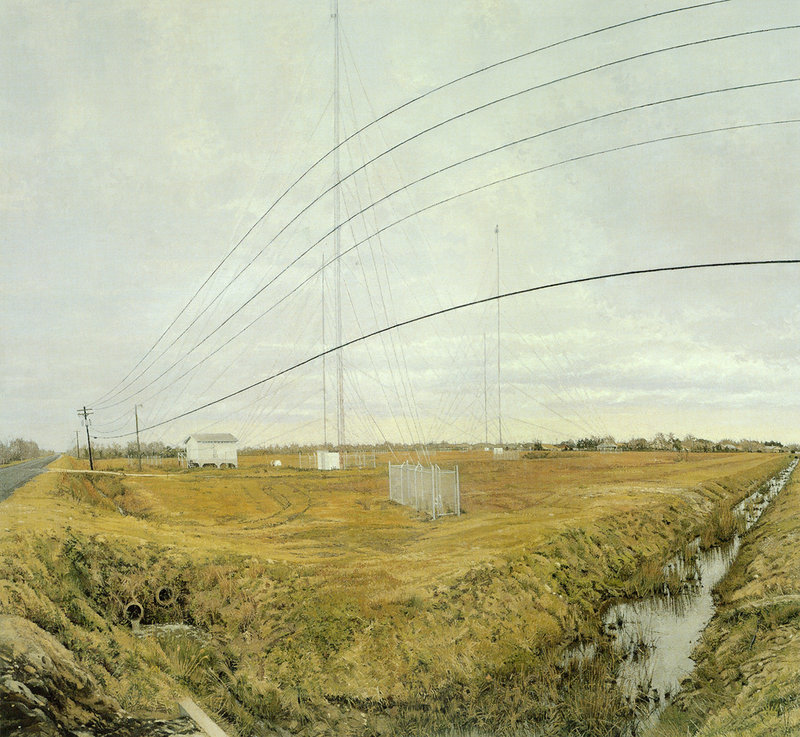The works in Rackstraw Downes’ exhibition “Onsite Paintings, 1972-2008” at the Portland Museum of Art first struck me as psychologically disengaged renderings of unexciting panoramas.
A typical Downes painting is a long, thin industrial landscape. “In the High Island Oil Field, February, After the Passage of a Cold Front” (1990), for example, shows the barren Texas oil landscape — an expanse of flat, dry dirt scuffed with a few tufts of scraggly brush under a grayish, dusty blue sky. Three smallish pump rigs sit in the left foreground. A few others litter the vast space otherwise populated by little more than a distant pole line and a remote band of trees.
The most striking element is the sweeping curve of the horizon line. Virtually all of Downes’ paintings have this effect, which looks rather like an exaggeration of the curved optical distortion of a camera.
However, Downes works directly from what he observes on site, so the swooping perspective isn’t a photographic effect.
I think the spatial exaggeration is how Downes makes single-point perspective a non-issue. This way, we don’t see perspective aberrations as mistakes, and Downes has great freedom to create structure in a highly unified image. The curving is Downes’ gesture — the product of his arm as much as his eye and his mind. It is his and his alone.
Downes’ realistic technique is excellent but rather anonymous, so the curving defines most of the works: “The Mouth of the Passawaukeag” (1989) is a two-part canvas in which the sweep bends more on the left side. Structurally, it is complex and brilliantly resolved. But otherwise, is it largely gritty and workaday.
His “Four Spots Along a Razor-Wire Fence” (1999) comprises four canvases picturing a grim urban landscape. It features some gorgeously painted passages (the wire), but is otherwise largely devoted to echoing its own perspectival curves.
The New York City scenes are my least favorite. They are unified images of often amazing complexity, but they have the predictable feel of architectural renderings — cold and impersonal. An exception to this is the 1998 interior view of an empty space in the World Trade Center. It is a transitional painting of a space in transition. Downes’ rich color sense is revealed in the incessant grays, and his quirky presence adds unexpected life to an otherwise empty room. It is the sparest scene in the show, but it features the richest sense of painting.
The most impressive work is “At the Confluence of Two Ditches Bordering a Field with Four Radio Towers” (1995). It’s a squarish composition seen from a crossroads at the corner of a field, with ditches running along each edge. Downes employs two perspective points — one at each of the points where the ditches vanish on the horizon. The center of the canvas shows the field with its wire-supported antennae and a few ancillary structures. It’s a forgotten place — gray skies over some ugly field never intended to be seen, let alone savored.
The most striking element is the set of four electrical wires that curl across the canvas with shocking lyrical boldness. Their looping grace and intervals are wonderfully musical.
This painting has a lot of moving parts, and Downes pulls them together perfectly: the curve of the wires, the beautifully painted grass in the foreground, the way Downes reveals the wires by painting around them, the inverted echo of the double perspective’s pyramidal space by the pyramidal towers and so much more.
“Confluence” could only have been made by a mature, brilliant and supremely talented painter — and that seems to be the entirety of its cold and not particularly appealing message.
This is the problem with the entire show: these are intellectually anxious paintings of bleak and lonely landscapes.
In the exhibition catalog, Downes says his work is not self-expressive but rather “a challenge to my resources as a painter.” This is fine for a teacher or a student, but what’s in it for us?
The catalog essays reiterate an “anxiety of influence” (Harold Bloom, 1973) that I immediately sensed as Downes’ uncomfortable relationship with Impressionism.
We often forget Impressionism was supremely radical. Impressionists showed modern life and industrial scenes; they painted spontaneously en plein-air. Compared to the glazed confections of the Academy, the public first found Impressionism gritty and ugly.
Downes is a child of Impressionism, but his ambition wants him to be past it.
I don’t like this show because Downes seems more concerned with proving he is an important painter than with making good paintings. I admire his schooled brilliance, his patient efforts and his prodigious talent, but there is an unseemly arrogance to Downes’ work that makes you think he cares more about history than his audience.
This is a show for fans of intellectually-oriented contemporary art. I really enjoyed discussing the paintings with others, but I did not enjoy seeing them by myself — and I doubt I am alone in that opinion.
Freelance writer Daniel Kany is an art historian who lives in Cumberland. He can be contacted at:
dankany@gmail.com
Send questions/comments to the editors.




Success. Please wait for the page to reload. If the page does not reload within 5 seconds, please refresh the page.
Enter your email and password to access comments.
Hi, to comment on stories you must . This profile is in addition to your subscription and website login.
Already have a commenting profile? .
Invalid username/password.
Please check your email to confirm and complete your registration.
Only subscribers are eligible to post comments. Please subscribe or login first for digital access. Here’s why.
Use the form below to reset your password. When you've submitted your account email, we will send an email with a reset code.